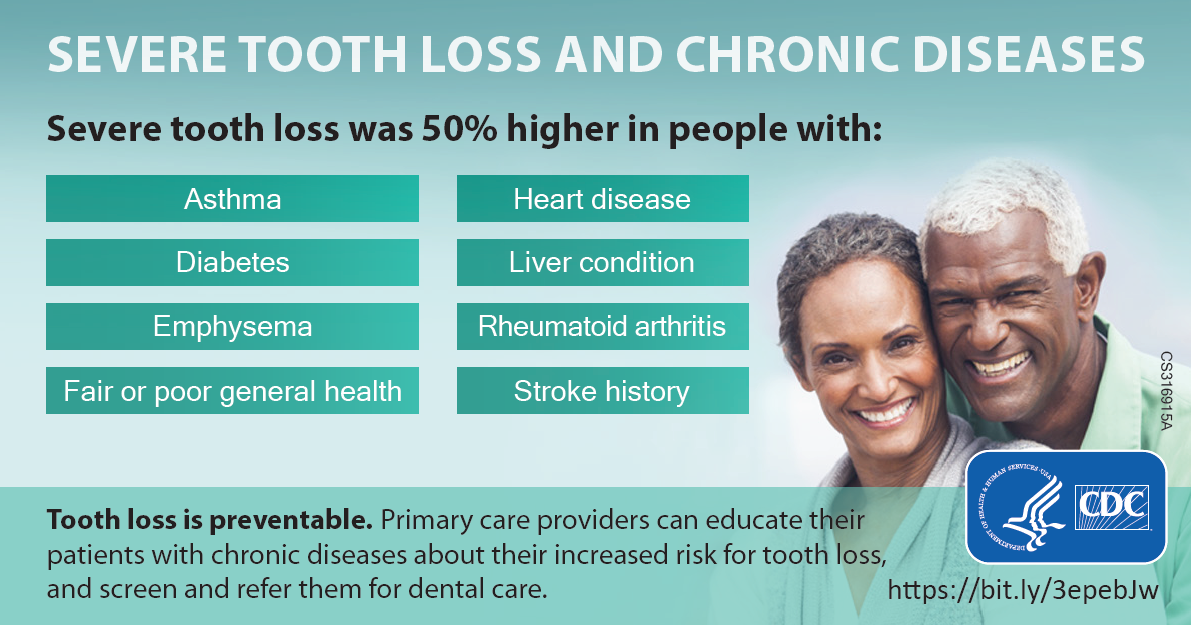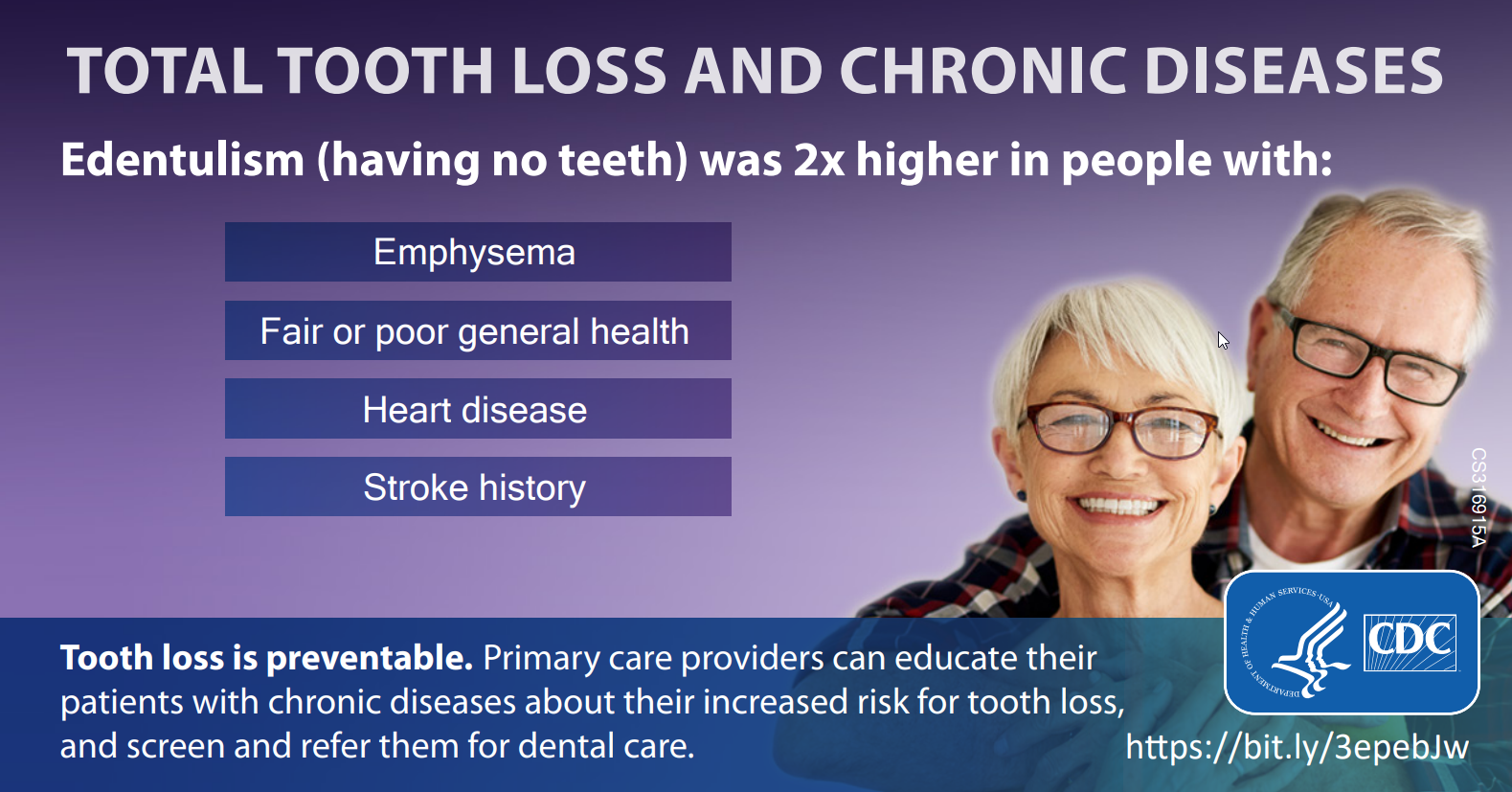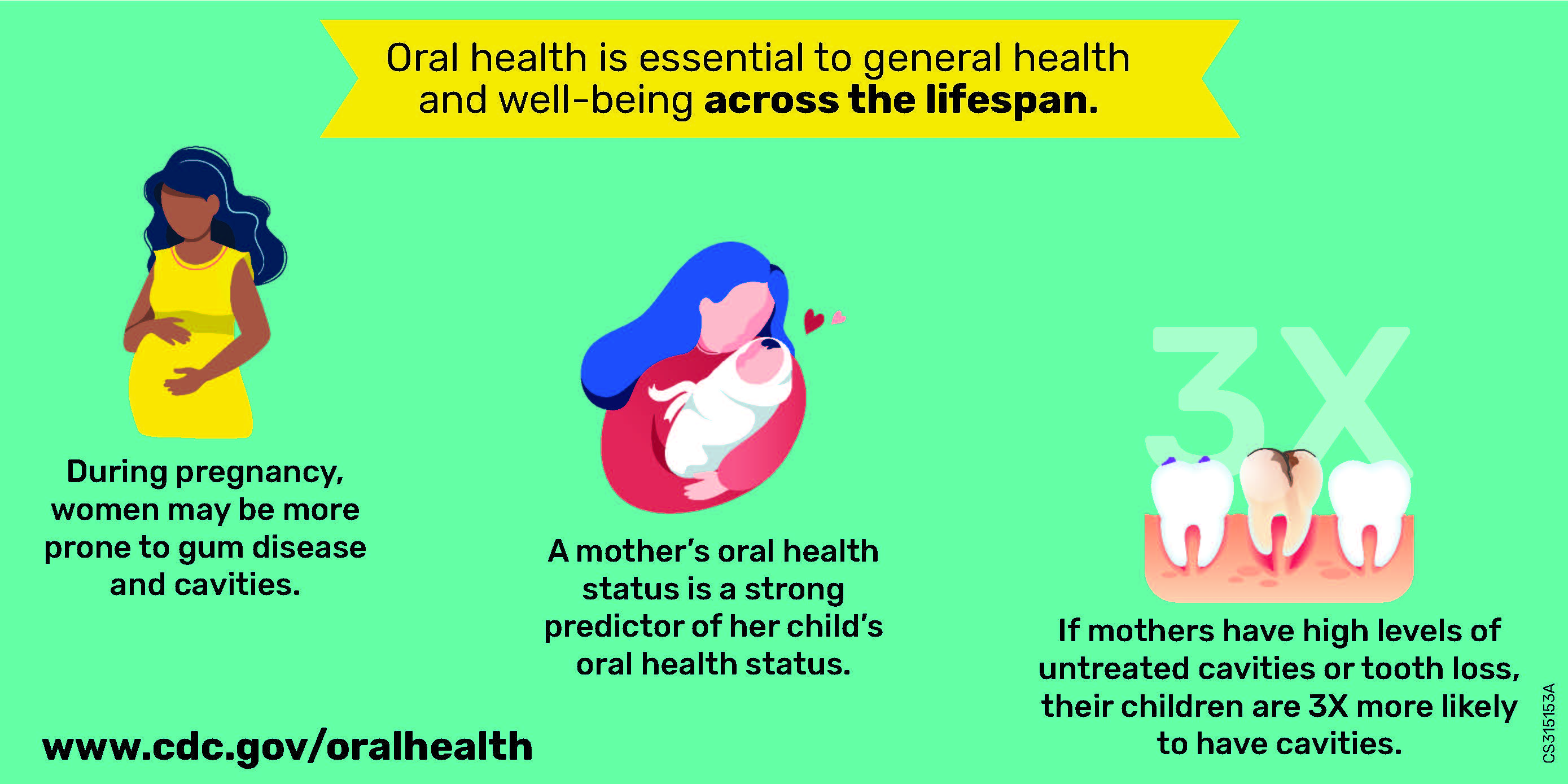Information for Professionals
“Oral health is essential to the general health and well-being of all Americans, and it is a window into the health of the body. Oral health can show signs of nutritional deficiencies or general infection, and diseases that affect the entire body can first become apparent because of oral problems.” Surgeon General Priority in 2020
Oral health is essential for general health and well-being of all Missourians. Oral health problems affect a person’s ability to eat and speak. Poor oral health is inter-connected with serious health issues like diabetes, heart disease, stroke and preterm or low birth weight just to name a few. The good news is that oral health problems are preventable. A healthy smile for life starts with healthy habits of brushing and flossing, using fluoride toothpaste, making smart food choices and eating habits, and visiting the dentist twice a yearly.
All professionals need to be concerned about the oral health of all Missourians. This website provides resources to improve oral health outside of the dentist office. The information on this webpage is to help you learn and education others on the benefits of good oral health. As a professional - healthcare provider, dental provider, teacher or anyone else, you have the potential to influence the oral health of Missourians.
Just because the title of the resource may suggest a link or document is for one profession does not mean that other professionals will not find the information helpful, i.e. Oral Health Guide for Caregivers of School Aged Children. This guide contains good information and pictures regarding possible dental emergencies that may be seen anywhere not just at school.
Recent News
- Dentists and Dental Hygienists play a crucial role in delivering health care. The MU Center for Health Policy invites Dentists and Dental Hygienists working in Missouri to participate in a confidential workforce survey. The collected data provides clarity to better understand the characteristics of the Dental and Dental Hygienist workforce in Missouri, including practice locations, specialties, availability, and demographic characteristics. Below are the two surveys for Dental Hygienists and Dentists.
- Dental Hygienist Survey
- Dentist Survey
Children and Adolescents Oral Health
- Brush, Book, Bed from the American Academy of Pediatrics for children ages 0-6
- Preventive Services Program (PSP) is dedicated to promoting and improving healthy smiles for all Missouri children through education and preventive services. The PSP is a community-based oral health program that relies on various volunteers in a community to achieve success. The PSP has a four-method approach: 1. Oral screenings, 2. Oral health education, 3. Fluoride varnish applications, 4. Referrals for unmet dental needs. The PSP home page shares more information on the program including testimonials and fluoride varnish application videos.
- We offer a printable booklet to aide school nurses and others who work with school-aged children and minor dental emergencies. Email us at oralhealth@health.mo.gov to receive a PDF of the booklet. Ask for the booklet by name in your email. We will send to PDF to your email address.
Dry Mouth or Xerostomia & Sjogren’s Syndrome
- Dry Mouth Questions and Answers English | Spanish
- Dry Mouth – information from ADA
- Learn more about Sjogren’s Syndrome
Electronic Cigarette Use, Vaping and Oral Health
- Clearing the Air: The Relationship Between Electronic Cigarette Use, Vaping and Oral Health
- E-cigarette temperature may affect oral health by changing properties of inhaled aerosols
- Potential oral health effects of e-cigarettes and vaping: A review and case reports
- Harmful chemicals emitted from electronic cigarettes and potential deleterious effects in the oral cavity
The following links may be helpful for patients:
Eating Disorders and Oral Health
- Oral Effects of Eating Disorders
- Eating disorders and oral health: a matched case-control study
- Eating Disorders – ADA
The following links may be helpful for patients:
Fluoride and Oral Health
Fluoride for Strengthening Teeth
- Fluoride Fact Sheet for Health Professionals
- Fluoride Fact Sheet for Consumers
- Water Fluoridation
- Topical Fluoride Varnish: Below is a listing of resources that will be helpful when implementing an oral health component and topical fluoride varnish in your medical practice.
- The Mo HealthNet Dental Provider Manual Section 13.33 outlines information for medical profession regarding applying and billing for Topical Fluoride Varnish. Email us at oralhealth@health.mo.gov to receive a PDF of Section 13.33. Ask for the section by name in your email. We will send you the PDF to your email address.
- OPEN WIDE Oral Health Training for Healthcare Professionals helps healthcare and early childhood professionals (for example, Head Start, home visiting, and WIC staff) working in community settings to promote oral health in the course of promoting general health for infants, children, and their families.
- The American Academy of Pediatrics (AAP) Oral Health Education for Health Professionals
- Healthychildren.org AAP provides resources for oral health education in your practice.
This image reflects large areas of active tooth decay in a child’s baby teeth. The areas of decay are most likely caused by the child being put to bed with a bottle at an earlier age; the term is called “Early Childhood Caries” or also called “Baby Bottle Tooth Decay.” Babies should never be put to bed with a bottle filled with any liquid, if a bottle is necessary at bedtime, tap water should be the only choice.

ICD-10 Dental Diagnosis Codes
Medical and Oral Health Issues
- Americans Are Still Not Getting the Dental Care They Need
- Burning Mouth Syndrome
- Detecting Oral Cancer, A Guide for Healthcare Professionals
- Head and Neck Cancer and HPV
- Medical-Dental Integration
- Missed Connections: Providers and Consumers Want More Medical-Dental Integration
- Recent Trends in Hospital Emergency Department Visits for Non-Traumatic Dental Conditions
MHPPS - Health Professional Financial Incentive Program
Missouri Health Professional Placement Services provides links to financial incentive programs that you may qualify for whether you are a student, a resident or already in practice. Go to Missouri Health Professional Placement Services | Financial Incentive Program to start your search.
Older Adults and Oral Health

- Best Practice Approach: Improving The Oral Health of Older Adults
- Locate Low-Cost Dental Services in Missouri
- Oral Health and Aging Brushing Guide English | Spanish
- Oral Health and Aging Dry Mouth English | Spanish
- Oral Health and Aging: Flossing Guide English | Spanish

Oral Care for People with Developmental and/or Physical Disabilities
- Children with Special Health Care Needs: An Introduction to Practical Oral Care for People with Developmental Disabilities, the National Institute for Dental and Craniofacial Research (NIDCR) provides a series of publications, Practical Oral Care for People with Developmental Disabilities, equips dental professionals in the community with the basic information they need to deliver quality oral health care to people with special needs. In addition, NIDCR provides information on developmental disabilities and strategies for care. NIDCR provides two continuing education credits upon successful completion of a post-test, see the section ‘For Dental Professionals.’
- An Oral Health Professional’s Guide to Serving Young Children with Special Health Care Needs is a series of five self-contained online modules designed to provide oral health professionals with information to help ensure that young children with special health care needs have access to health promotion and disease prevention services that address their unique oral health needs in a comprehensive, family-centered, and community-based manner. This curriculum was developed by a multidisciplinary team of experts with funding from the Maternal and Child Health Bureau, Health Resources and Services Administration.
- Planning Guide for Dental Professionals Serving Children with Special Health Care Needs was developed by the University of Southern California University Affiliated Program, Children’s Hospital Los Angeles that helps oral health professionals better communicate and work with families to ensure that appropriate, quality oral health care is provided both at home and in the dental office.
- Children and Adolescents with Special Health Care Needs
- Oral Health Care for Children and Adolescents with Special Health Care Needs Resources
Oral Health Education
- The Office of Dental Health offers free materials regarding oral health at Oral Health Education

